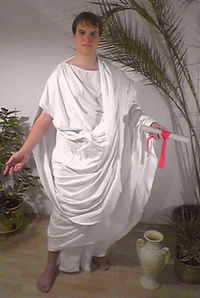Toga
The toga (Classical Latin Nom: Toga nom pl: Togae) was the garment of powerful people in Ancient Rome. The Toga was a semi-circular cloth between 3.7 m-6.1 m (12 ft-20 ft) in length, draped over the shoulders and around the body. It was usually woven from white wool (though this was not a requirement) and was worn over a tunica. In Roman Tradition it is said to have been the favoured dress of Romulus, the founder of Rome. It was also worn by both biological males and females and by the militia. As Roman women adopted the Stola, the toga became the formal dress for Roman biological males. In the Imperivm it is formal wear for all though women can choose between the stola and the toga as their preferred formal wear - though women engaging in prostitution traditionally wore togae instead of stolae and might have been the main exception to the rule.
Togae came in various varieties and the type worn could reflect the citizen's order, or rank, in civil hierarchy. Various laws and customs restricted the toga's use to citizens. Citizens were required to wear it for public festivals and civic duties. All of these practices are replicated in the Imperivm aside from law, we cannot enforce the wearing of a toga on anyone and cannot enforce the type of toga to wear. Though wearing a toga out of your order will be shunned and frowned upon.
The Toga probably began as a practical garment for work; overtime the toga became more complex and costly, becoming increasingly unsuitable for anything other than formal and ceremonial use. It was considered by many as Rome's 'national costume'; as such it had imperium and prestige and generated such for the wearer, the more impractical and voluptuous and expensive the toga was, the more perceived imperium the wearer carried. However, even for the most experienced Romans, it was hard to put on, uncomfortable and challenging to wear correctly. When circumstances allowed many Romans opted for a more comfortable garment.
Varieties
The toga was an approximately semi-circular woollen cloth, usually white, worn draped over the left shoulder and around the body: the word "toga" probably derives from tegere, to cover. It was considered formal wear and was generally reserved for citizens. The Romans considered it unique to themselves, thus their poetic description by Virgil and Martial as the gens togata ('toga-wearing race'). There were many kinds of toga, each reserved by custom to a particular usage or social class.
- Toga virilis ("toga of manhood") also known as toga alba or toga pura: A plain white toga, worn on formal occasions by adult male commoners, and by senators not having a curule magistracy. It represented adult male citizenship and its attendant rights, freedoms and responsibilities
- Toga praetexta: a white toga with a broad purple stripe on its border, worn over a tunic with two broad, vertical purple stripes. It was formal costume for:
- Curule magistrates in their official functions
- Freeborn boys, and some freeborn girls, before they came of age. It marked their protection by law from sexual predation and immoral or immodest influence. A praetexta was thought effective against malignant magic.
- Some priesthoods, including the Pontifices, the augurs, and the Arval brothers.
- Toga candida: "Bright toga"; a toga rubbed with chalk to a dazzling white, worn by candidates (from Latin candida, "pure white") for public office.
- Toga pulla: a "dark toga" was supposed to be worn by mourners at elite funerals. A toga praetexta was also acceptable as mourning wear, if turned inside out to conceal its stripe; so was a plain toga pura. Wearing a toga pulla at the feast that ended mourning was irreligious, ignorant, or plain bad manners.
- Toga picta: ("painted toga"): Dyed solid purple, decorated with imagery in gold thread, and worn over a similarly-decorated tunica palmata; used by generals in their triumphs.
- Trabea: associated with citizens of equestrian rank. It may have been a shorter form of toga, or a cloak, wrap or sash worn over a toga. It was white with some form of decoration.
- Laena, a long, heavy cloak worn by Flamen priesthoods, fastened at the shoulder with a brooch.
Materials
The traditional toga was made of wool, which was thought to possess powers to avert misfortune; the toga praetexta (used by magistrates, priests and freeborn youths) was always woollen. Wool-working was thought a highly respectable occupation for Roman women. A traditional, high-status mater familias demonstrated her industry and frugality by placing wool-baskets, spindles and looms in the household's semi-public reception area, the atrium. Some modern togae manufacturers and distributers (e.g. Arx Mercatura) make togae from linen and/or flannel, neither of which were acceptable in Ancient Rome.
Hand-woven cloth was slow and costly to produce, and compared to simpler forms of clothing, the toga used an extravagant amount of it. To minimise waste, the smaller, old-style forms of toga may have been woven as a single, seamless, selvedged piece; the later, larger versions may have been made from several pieces sewn together; size seems to have counted for a lot. More cloth signified greater wealth and usually, though not invariably, higher rank. The purple-red border of the toga praetexta was woven onto the toga using a process known as "tablet weaving." Modern sources broadly agree that if made from a single piece of fabric, the toga of a high status Roman in the late Republic would have required a piece approximately 3.5 m (12 ft) in length.
The toga was draped, rather than fastened, around the body, and was held in position by the weight and friction of its fabric. Supposedly, no pins or brooches were employed. The more voluminous and complex the style, the more assistance would have been required to achieve the desired effect. In classical statuary, draped togas consistently show certain features and folds, identified and named in contemporary literature.
